Are you considering purchasing a second-hand iPhone or looking to sell your current one? Whether you are a buyer or seller, navigating the world of pre-owned smartphones can be a daunting task. With the high demand for iPhones and the constant release of new models, it’s no surprise that the market for second-hand devices is thriving. However, there are risks involved, such as purchasing a stolen device or one with hidden defects. To help you make informed decisions, this comprehensive guide will provide you with tips for buying and selling second-hand iPhones.
Buying a Second-Hand iPhone
If you’re in the market for a pre-owned iPhone, here are some essential tips to consider before making a purchase:
1. Know What You Want
Before you start browsing listings, determine which iPhone model you are interested in and what specifications you require. Consider factors such as storage capacity, color, and screen size.
2. Buy From Reputable Sources
When buying a second-hand iPhone, it’s crucial to purchase from reputable sources such as certified resellers, Apple’s official refurbished store, or well-known online marketplaces. Be cautious of deals that seem too good to be true, as they may be scams.
3. Check the IMEI Number
Before finalizing your purchase, always ask for the device’s IMEI number. You can use this number to check the phone’s status, including whether it has been reported lost or stolen.
4. Inspect the Device
Physically inspect the iPhone for any signs of damage, such as scratches, dents, or water damage. Check the buttons, speakers, and ports to ensure they are functioning correctly.
5. Check the Battery Health
Battery health is crucial when buying a pre-owned iPhone. Ask the seller to provide information on the battery’s health and how long it lasts on a full charge.
6. Verify Activation Lock
Make sure to check if the device is activation locked. An activation-locked iPhone will require the previous owner’s Apple ID and password to unlock, making it unusable for you.
7. Negotiate the Price
Don’t be afraid to negotiate the price with the seller, especially if you notice any defects or issues with the device. Compare prices from multiple sellers to ensure you are getting a fair deal.
Selling Your iPhone
If you’re looking to sell your used iPhone, here are some tips to help you get the best value for your device:
1. Prepare Your Device
Before listing your iPhone for sale, make sure to clean it thoroughly and remove all personal data. Reset the device to its factory settings to erase your information and disable any accounts linked to the phone.
2. Gather Accessories
If you have the original box, charger, headphones, or any other accessories that came with the iPhone, including them in the sale can increase its value.
3. Take High-Quality Photos
When creating your listing, take clear and detailed photos of the iPhone from various angles. Highlight any features or imperfections to provide potential buyers with a comprehensive view of the device.
4. Set a Realistic Price
Research the current market value of your iPhone model to set a competitive and realistic price. Consider factors such as the device’s condition, age, and any additional accessories included in the sale.
5. Choose the Right Platform
Decide where you want to list your iPhone for sale. Popular platforms include online marketplaces like eBay or Craigslist, dedicated apps like Swappa, or trade-in programs offered by Apple or mobile carriers.
6. Be Honest About the Device
When creating your listing, be transparent about the iPhone’s condition, any flaws or issues it may have, and the reason you are selling it. Honesty builds trust with potential buyers and can result in a smoother sales process.
7. Negotiate Responsibly
Be prepared to negotiate the price with potential buyers, but also know your bottom line. Consider setting a firm price or indicating that the price is non-negotiable to avoid unnecessary haggling.
Frequently Asked Questions (FAQs)
1. Can I return a second-hand iPhone if I am not satisfied with it?
While policies vary among sellers, many second-hand iPhone purchases are final. Be sure to clarify the seller’s return policy before completing the transaction.
2. Is it safe to buy a second-hand iPhone online?
Buying a second-hand iPhone online can be safe if you purchase from reputable sources and take necessary precautions. Ensure that the seller has positive reviews and offers secure payment options.
3. Should I buy a refurbished iPhone or a used one?
Refurbished iPhones have undergone thorough testing and come with a warranty, making them a safer option than buying a regular used iPhone. However, refurbished devices are typically more expensive.
4. How can I check if an iPhone is stolen before purchasing it?
You can check the status of an iPhone by using its IMEI number on websites like the CTIA Stolen Phone Checker or the Apple Activation Lock status page.
5. Do I need to unlock my iPhone before selling it?
If your iPhone is carrier-locked, you may need to unlock it before selling it to broaden the potential buyer pool. Contact your carrier for assistance in unlocking the device.
6. What is the best way to ship a sold iPhone to the buyer safely?
When shipping a sold iPhone, use a reputable courier service that provides tracking information and insurance. Ensure the device is securely packaged to prevent damage during transit.
7. Can I sell an iPhone that is not in working condition?
Yes, you can sell a non-working iPhone for parts or repair. Be transparent about the device’s condition when listing it for sale and adjust the price accordingly.
8. Should I sell my iPhone to a trade-in program or try to sell it privately?
Trade-in programs offered by Apple and mobile carriers may provide convenience and a guaranteed price for your device. However, selling your iPhone privately can often yield a higher resale value.
9. What information should I provide when selling my iPhone online?
When creating a listing for your iPhone, provide details about the device’s model, storage capacity, condition, any included accessories, and the reason for selling. Highlight any unique features or upgrades.
10. How can I protect myself from scams when buying a second-hand iPhone?
To protect yourself from scams, always purchase from reputable sources, verify the device’s IMEI number, avoid deals that seem too good to be true, and trust your instincts if something feels off during the transaction.
In conclusion, whether you are buying or selling a second-hand iPhone, thorough research, careful inspection, and honest communication are key to a successful transaction. By following the tips outlined in this guide and being vigilant throughout the process, you can make a confident decision and ensure a smooth and satisfying experience.

